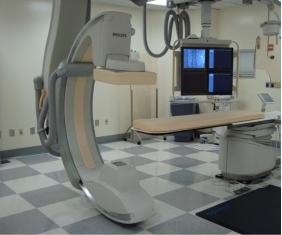What is Interventional Radiology?

This IR table allows x-ray images to be taken as needed to assist with the procedure.
Interventional Radiology (IR or VIR for Vascular Interventional Radiology) is a subspecialty of radiology in which minimally invasive procedures are performed using image guidance (fluoroscopy/X-Ray). IR is used for diagnostic and therapeutic care for a wide variety of vascular and nonvascular conditions throughout the body. IR is also sometimes referred to as “Special Procedures.”
What Is Interventional Radiology used for?
IR offers an alternative to the surgical treatment of many conditions and can eliminate the need for hospitalization, in some cases. An Interventional Radiologist is a board-certified physician who specializes in minimally invasive targeted treatments. These specialized physicians offer the most in-depth knowledge of the least invasive treatments available, coupled with diagnostic and clinical experience across all specialties. They use X-Ray and other imaging to advance a catheter and other small instruments in the body to diagnose or treat the disease, non-surgically. As the inventors of angioplasty and the catheter-delivered stent, Interventional Radiologists pioneered minimally invasive modern medicine.
Specials Forms & Information
- Abscess Drain Placement
- Abscessogram
- Adrenal Biopsy
- Asept Drain Only (Thoracentesis or Paracentesis)
- Asept Drain Placement (Thoracentesis or Paracentesis)
- Asept Drain Removal
- Biliary Tube Check and Change
- Biopsy in CT or Ultrasound
- Blood Patch
- Bone Biopsy
- Bone Marrow Biopsy
- Breast Biopsy
- Central Line Placement
- Central Line Removal
- Chest Tube Placement
- Cryoablation
- Disc Aspiration
- Drain Check and Change
- Embolization
- Epidural Steroid Injection (ESI)
- Facet Injection
- Fine Needle Aspiration in CT or IR
- Fine Needle Aspiration in Ultrasound
- Gastrostomy Tube Check/Change
- Gastrostomy Tube Removal
- IVC Filter Placement
- Joint Aspiration/Injection in IR
- Joint Aspiration in Ultrasound
- Kidney Biopsy (Random or Targeted)
- Kyphoplasty
- Liver Biopsy
- Lung Biopsy
- Lymph Node Biopsy in CT
- Lymph Node Biopsy in Ultrasound
- Marker Placement in CT
- Microwave Ablation
- Muscle Biopsy
- Nephrostomy Tube Check/Change
- Nerve Root Block
- Pancreatic Biopsy
- Paracentesis
- Percutaneous Gastrostomy Tube Placement
- Percutaneous Nephrostomy Tube Placement
- Percutaneous Transhepatic Cholangiogram (PTC)
- Percutaneous Ureteral Cath Placement
- Perm Cath Removal
- Perm Cath Placement
- PICC Check
- PICC Line Placement
- Port Check
- Port Placement
- Port Removal
- Retroperitoneal Biopsy
- Sclerosing in US
- Suprapubic Catheter Check/Change
- Suprapubic Catheter Placement
- Thyroid FNA/Biopsy
- Uterine Fibroid Embolization (UFE)
- Venogram
- Venous Sampling
- Y90 Mapping
- Y90 Treatment

